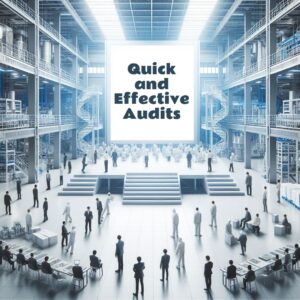What are the differences between 5s audit & 6s audit?
The 5s audit & 6s audit are both tools used in lean manufacturing and workplace organization methodologies, but they differ in their approach and scope.
Here’s a breakdown of the key differences between 5s audit & 6s audit:

- 5S Audit:
- Scope: The 5S methodology focuses on creating and maintaining a clean, organized, and efficient workplace by addressing five key elements: Sort, Set in order, Shine, Standardize, and Sustain.
- Elements:
- Sort: Separating necessary items from unnecessary items and removing the latter from the workplace.
- Set in order: Organizing necessary items in a logical and efficient manner, ensuring they are easily accessible.
- Shine: Cleaning and maintaining the workplace to keep it tidy and free from clutter.
- Standardize: Establishing standardized procedures and practices for maintaining the first three S’s.
- Sustain: Creating a culture of continuous improvement by ensuring that the 5S principles are consistently applied and maintained.
- Audit Process: A 5S audit typically involves assessing the implementation and adherence to these five principles through periodic inspections and evaluations.
- 6S Audit:
- Extension of 5S: The 6S methodology builds upon the principles of 5S by adding a sixth element, Safety.
- Elements:
- Safety: Emphasizes the importance of identifying and addressing safety hazards in the workplace to ensure the well-being of employees.
- Audit Process: In addition to evaluating the Sort, Set in order, Shine, Standardize, and Sustain aspects of the workplace, a 6S audit includes assessing safety practices and protocols. This can involve identifying potential safety hazards, ensuring compliance with safety regulations, and promoting a culture of safety among employees.
In summary, while both the 5s audit & 6s audit aim to improve workplace organization and efficiency, the 6S audit expands upon the 5S methodology by incorporating safety as a fundamental aspect of workplace improvement efforts.


Whether a 6S audit is “better” than a 5S audit depends on the specific needs and priorities of the organization. Both audits have their advantages and serve different purposes. Here are some reasons why an organization might find a 6S audit beneficial:
- Enhanced Safety: The addition of the safety element in the 6S audit ensures that workplace safety is given the attention it deserves. By incorporating safety practices into the audit process, organizations can reduce the risk of accidents and injuries, leading to a safer work environment for employees.
- Comprehensive Evaluation: A 6S audit provides a more comprehensive evaluation of the workplace by considering not only organization and efficiency (the focus of 5S) but also safety. This broader scope allows organizations to address a wider range of issues that may affect productivity, quality, and employee well-being.
- Legal Compliance: Ensuring compliance with safety regulations and standards is critical for organizations to avoid fines, penalties, and legal liabilities. By incorporating safety assessments into the audit process, organizations can proactively identify and address potential compliance issues.
- Employee Engagement: Safety is a fundamental concern for employees, and incorporating safety practices into the workplace can enhance employee engagement and morale. Employees are more likely to feel valued and motivated in a safe work environment, leading to increased productivity and satisfaction.
- Risk Mitigation: By identifying and addressing safety hazards through the 6S audit, organizations can mitigate the risk of accidents, injuries, and other incidents that could disrupt operations, damage equipment, or harm employees.
